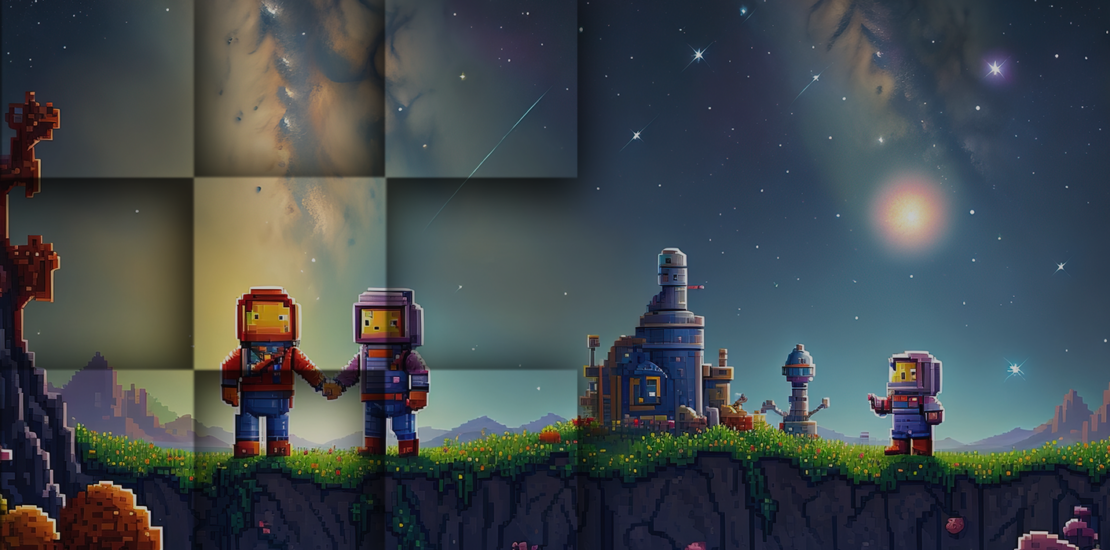- July 19, 2024
- Posted by: iXie
- Category: Game Development

In a world full of ordinary game icons, screenshots alone can’t show your game’s true story and world. That’s where key art comes in. It can turn a simple look into an emotional connection. As a 2D artist, you have the chance to create these amazing visuals that not only promote games but also spark players’ imaginations and leave a lasting impact.
In this guide, we’ll reveal the secrets to making stunning key art. We’ll cover the important skills, artistic basics, and industry tips that will help you create visuals that connect with players and take your games to the next level.
Are you ready to unleash your creativity and turn your love for art into a successful career in game marketing? Let’s get started!
Contents
The 2D Marketing Artist’s Toolkit
A 2D marketing artist is more than just an artist; they are skilled professionals with a wide range of abilities. Let’s look at the essential tools you need:
Software Skills
Being good with industry-standard software is a must. Artistic talent is important, but you also need to know how to use digital tools to showcase your skills.
- Adobe Photoshop. Essential for photo editing, digital painting, and creating raster-based artwork.
- Adobe Illustrator. Perfect for vector graphics, logos, typography, and making scalable assets for different platforms.
- Other Tools. Consider using other software like Procreate (for iPad illustration), Affinity Designer (an alternative to Photoshop and Illustrator), or 3D software like Blender (for creating 3D assets to include in your 2D work).
Pro Tip: Don’t just stick to the basics—master advanced techniques like layer blending, masking, brushes, and filters to fully express your artistic vision.

Artistic Foundations
Strong artistic skills are crucial for creating eye-catching artwork.
- Composition. Learn how to arrange elements to lead the viewer’s eye through the piece.
- Color Theory. Use colors to create emotions, contrast, and set the mood.
- Typography. Pick fonts that match the artwork and enhance the message.
- Anatomy and Perspective. For realistic characters and settings, understand these concepts well.
- Lighting and Shading. Use light and shadows to give your artwork depth and dimension.
Pro Tip: Keep learning about art and design. Try different styles, study successful artwork, and practice new techniques to grow your skills.
Game Knowledge
To create effective key art for a game, you need to thoroughly understand the game you’re promoting.
- Genre and Setting. Research the game’s genre (like fantasy, sci-fi, action) and its setting (such as medieval, futuristic, or post-apocalyptic) to guide your visual choices.
- Target Audience. Identify who the game is meant for, including their age and interests, so you can tailor your artwork to what they like.
- Unique Selling Points (USPs). Show off the game’s most exciting features and unique mechanics in your artwork to attract potential players.
- Story and Characters. If the game has a strong story or memorable characters, include them in your artwork to create intrigue and emotional connection.
Pro Tip: Regularly communicate with marketing and game development teams to ensure your artwork aligns with their vision and goals.
Marketing Savvy
Understanding marketing principles helps you create artwork that looks great and promotes the game effectively.
- Target Platforms. Adapt your key art to meet the needs of different platforms like social media banners and app store icons.
- Campaign Goals. Make sure your artwork matches the overall marketing strategy. Whether the goal is to drive pre-orders, increase brand awareness, or announce a new feature, align your art with these goals.
- Trends and Competitors. Stay updated on current trends in game marketing art. Analyze competitor artwork to see what works and what doesn’t.
Pro Tip: Regularly communicate with marketing and game development teams to ensure your artwork aligns with their vision and goals.
By mastering these principles, you’ll be able to create key art that not only attracts viewers but also encourages them to engage with the game you’re promoting.

The Key Art Creation Process
Creating impactful key art is rarely straightforward. It’s a blend of collaboration, ideas, technical work, and constant improvement. Here’s a simplified breakdown of the process:
1. Concepting and Collaboration
Key art usually doesn’t come fully formed from one person’s mind. It starts with an idea, mood, or a game scene that stands out. Collaboration with marketing and game development teams is essential.
- Brainstorming Sessions. Gather the team to share ideas, reference images, and discuss the game’s main themes and selling points.
- Mood Boards. Create visual collages to set the tone, color palette, and overall look.
- Early Sketches. Make rough sketches to explore different compositions and character poses.
Pro Tip: Experiment and iterate at this stage to generate many ideas before narrowing down.
2. Sketching and Refinement
After choosing a concept, refine it into a more polished sketch. This is where artistic skills and understanding of composition are crucial.
- Detailed Sketches. Focus on character expressions, anatomy, perspective, and other visual elements.
- Feedback Loop. Share sketches with the team and gather feedback. Be open to suggestions and revisions.
- Iteration. Refine sketches based on feedback until you have a clear vision for the final artwork.
Pro Tip: Use references from similar games, movies, or artwork to inspire your composition and style.
3. Final Execution
Translate your sketches into a high-resolution digital artwork, paying attention to detail and ensuring it meets the specifications for various platforms.
- Digital Painting/Illustration. Use software like Photoshop or Illustrator to create the final artwork, focusing on lighting, shadows, textures, and depth.
- 3D Asset Integration. If your artwork includes 3D elements, integrate them seamlessly into your 2D composition.
- Typography and Graphics. Add any necessary text (e.g., game title, logo) and ensure it’s readable and visually appealing.
Pro Tip: Take breaks and revisit your work with fresh eyes to spot errors or areas for improvement.
4. Adaptation and Iteration
Your key art needs to be adapted for various platforms and formats, each with its own requirements.
- Social Media Banners. Create visuals that stand out in crowded feeds.
- App Store Icons. Design a memorable icon that captures the game’s essence.
- Website Hero Images. Create impactful images for the game’s website.
- Physical Marketing Materials. Adapt your artwork for posters, flyers, and other promotional items.
Pro Tip: Maintain consistency across all platforms. Each version may vary slightly, but the overall look and feel should be cohesive.
By understanding and embracing this process, you’ll be equipped to create key art that meets marketing objectives and resonates with players. Remember, creating key art is a journey. Embrace the challenges and enjoy the creative rewards!
Career Path
The journey of a 2D marketing artist is all about growth and creativity. Let’s look at the common stages, from beginner to expert:
Starting Out: Getting Your First Job In creative fields, you often begin with smaller projects to prove your skills.
- Junior Artist Roles. Look for jobs like Junior Marketing Artist, 2D Artist (Marketing), or Graphic Designer (Games).
- Indie Game Studios. Small studios offer hands-on experience and the chance to try different roles.
- Internships. Even unpaid internships provide essential experience and networking opportunities.
- Freelancing. Building a freelance portfolio can showcase your skills and attract clients.
Pro Tip: Network within the gaming community by attending events, joining online forums, and connecting with other artists.
Building a Portfolio
Your portfolio is crucial in game marketing art.
- Show Your Best Work. Include only your strongest pieces to highlight your versatility.
- Target Your Audience. Research the studios and games you’re interested in and tailor your portfolio accordingly.
- Online Presence. Create a website or online portfolio to present your work professionally.
- Personal Projects. If you lack professional experience, make personal projects to demonstrate your skills.
Pro Tip: Get feedback from experienced artists or mentors to improve your portfolio.
Senior Roles and Specializations
With experience and a solid portfolio, you can move up to senior roles and specializations.
- Senior Marketing Artist. Lead projects, mentor junior artists, and help shape the creative direction of campaigns.
- Art Director. Oversee the entire art team and ensure the campaign’s visual elements match the overall strategy.
- Genre Specialist. Focus on a specific genre (e.g., fantasy, sci-fi) and become an expert in its visual style.
- Style Specialist. Develop a unique artistic style that makes you sought-after for specific projects.
Pro Tip: Keep developing your skills and stay updated on industry trends to remain competitive.
The Evolving Landscape
The game industry is always changing, and as a marketing artist, you need to keep up.
- New Technologies. Use tools like AI-powered image generation to enhance your workflow.
- Industry Trends. Stay informed about the latest trends in game marketing art, including visual styles and platform requirements.
- Lifelong Learning. Continue learning through online courses, workshops, and experimenting with new techniques.
Pro Tip: Be adaptable and open to change. The best marketing artists are those who can evolve with the industry.
Remember, your career path is your unique journey. By focusing on continuous learning, building a strong portfolio, and embracing change, you’ll become a master of key art and a valuable member of any game development team.
Conclusion
Key art isn’t just about marketing; it’s what draws players in emotionally. It’s about creating memorable images that shape how people see the game and get them excited.
As a 2D marketing artist, you’re telling stories through your art, setting trends, and playing a key role in a game’s success.
Check out online communities, tutorials, and industry blogs to boost your creativity and improve your skills. Remember, every great game needs a standout piece of art. With your talent and passion, you can make it happen.
What do you think about the power of key art? Share your experiences and insights in the comments below!
FAQ’s:
Key art is a visually compelling image used to promote a game. It captures the game’s essence, story, and characters to attract and engage potential players.
Key art creates an emotional connection with players, making the game memorable and appealing. It serves as the first impression and can significantly influence a player’s decision to try the game.
Essential skills include proficiency in industry-standard software (like Adobe Photoshop and Illustrator), a strong understanding of artistic principles (composition, color theory, anatomy), and knowledge of the game being promoted.
Begin with building a strong portfolio, possibly through freelance work or internships. Seek junior roles in indie studios or larger companies and continuously develop your skills and network within the industry.
Commonly used software includes Adobe Photoshop for digital painting and photo editing, Adobe Illustrator for vector graphics, and other tools like Procreate for iPad illustration and Blender for integrating 3D assets.
